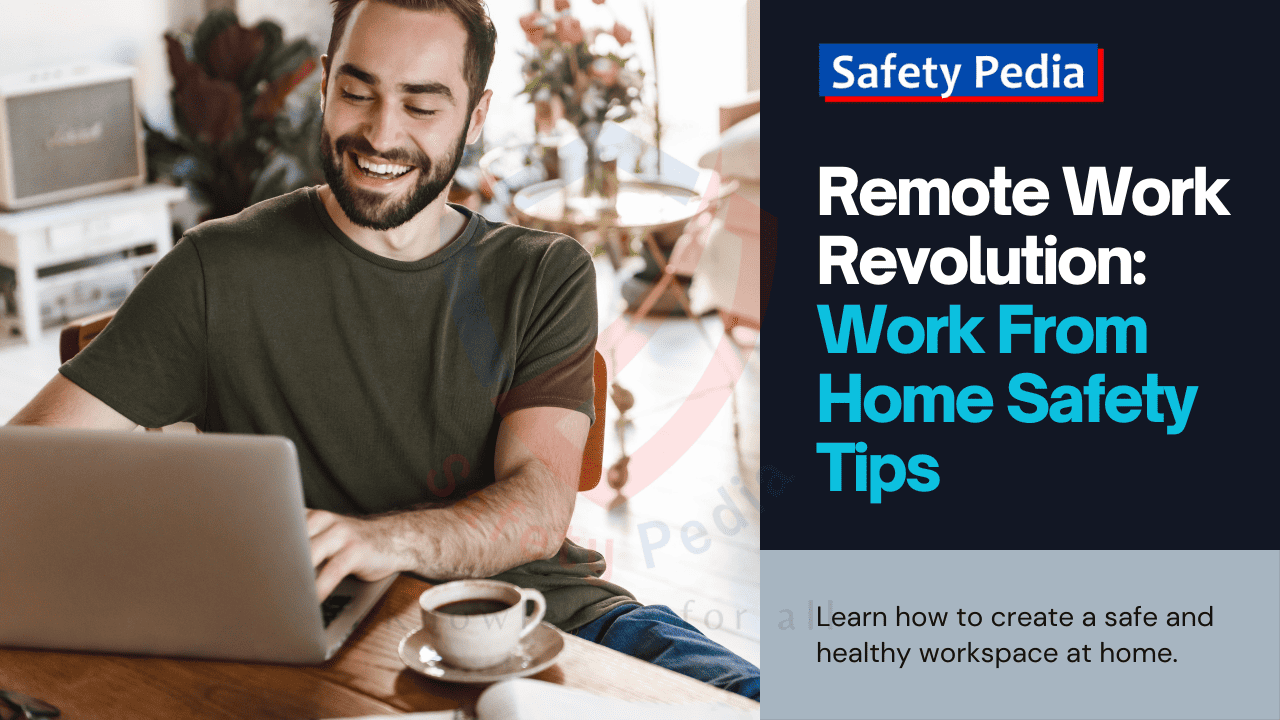Introduction: Work From Home Safety Tips
The pandemic has changed the way we work, and many people have adopted the benefits of working from home. However, remote work also comes with some challenges and risks that need to be addressed. In today’s digital age, more and more people are opting to work from the comfort of their homes. While it brings flexibility and convenience, it also comes with its own set of safety and security risks.
Working from home has become the new normal for many people, offering the flexibility and comfort that traditional office spaces may lack. However, with this shift comes the need to ensure the safety of both our physical space and our digital workspace. Whether you’re a freelancer, a remote employee, or a business owner, it’s important to take steps to protect yourself, your family and your digital workspace.
Additionally, we’ll get through the importance of maintaining a healthy work-life balance, setting boundaries, and creating a productive working environment.
This article will provide you with essential tips and practices to ensure work-from-home safety. By implementing these essential tips, you can ensure that your work from home experience is not only efficient but also safe and secure. Don’t wait – start protecting your home and digital workspace today!
Maintaining mental and physical well-being while working from home
When working from home, it’s crucial to prioritize your mental and physical well-being. Without the structure of a traditional office environment, it’s easy to fall into unhealthy habits. Here are a few tips to help you maintain a healthy work-life balance and take care of yourself:
- Establish a routine: Set a schedule that includes dedicated time for work, breaks, and personal activities. Stick to this routine as much as possible to create a sense of structure and normalcy.
- Create a designated workspace: Designate a specific area in your home as your workspace. This will help you separate your professional and personal life and improve focus and productivity.
- Establish a regular routine and boundaries. Working from home can blur the lines between work and personal life, which can affect your mental health and productivity. To prevent this, create a schedule that works for you and stick to it. Set clear start and end times for your workday, and take breaks in between. Communicate your availability and expectations with your colleagues, clients, and family members. Respect your own boundaries and don’t let work interfere with your personal time.
- Take regular breaks: Just like you would in an office setting, take regular breaks to clear your mind and refresh your energy. Step away from your workspace, stretch, or engage in activities that help you relax and recharge.
Maintaining your mental and physical well-being is essential for long-term work from home success. By prioritizing self-care, you can ensure that you stay healthy, productive, and motivated.
Physical safety tips for your home workspace
Creating a safe physical environment is crucial when working from home. Here are some important tips to ensure the physical safety of your home workspace:
- Ensure proper lighting: Good lighting is essential for reducing eye strain and increasing productivity. Position your workspace near a window for natural light or invest in bright, adjustable desk lamps.
- Keep walkways clear: Remove any potential tripping hazards such as loose cables or clutter from your workspace. A clear and organized area will help prevent accidents and injuries.
Taking these physical safety measures will create a secure and comfortable workspace, reducing the risk of accidents and promoting overall well-being.
Ergonomics and physical well-being
When working from home, it’s crucial to prioritize ergonomics and physical well-being to avoid health issues that can arise from prolonged sitting and poor posture. Set up an ergonomic workstation by investing in a comfortable chair, an adjustable desk, and a monitor stand to ensure proper alignment of your body. Take regular breaks and stretch your muscles to prevent stiffness and muscle strain.
Invest in ergonomic furniture, working from home can be tempting to work from your couch or bed, but this can lead to poor posture, back pain, and eye strain. To avoid these problems, invest in a good chair, desk, and monitor that suit your height and preferences. Make sure you have enough space, lighting, and ventilation in your workspace. You can also use accessories like a keyboard, mouse, headset, and webcam to improve your comfort and communication. Consider investing in an ergonomic chair and desk to support proper posture and reduce the risk of back pain and other musculoskeletal issues.
Creating a designated workspace away from distractions like the kitchen or living room can also contribute to better focus and productivity. Keep your workspace well-lit and properly ventilated, and consider adding plants to improve air quality and create a calming atmosphere. By taking care of your physical well-being, you can optimize your work from home experience.
Cybersecurity tips for protecting your digital workspace
Securing your digital workspace is just as important as protecting your physical space. Start by using strong, unique passwords for all your online accounts and consider using a password manager to keep track of them. Enable two-factor authentication whenever possible to add an extra layer of security.
Invest in reliable antivirus software and keep it up to date to protect your devices from malware and viruses. Regularly update your operating system and applications to ensure you have the latest security patches. Be cautious when downloading files or clicking on links, as phishing scams and malware attacks are common. Always verify the source and validity of emails, especially those requesting sensitive information.
Encrypt your Wi-Fi network to prevent unauthorized access, and use a virtual private network (VPN) when connecting to public Wi-Fi networks. Back up your important files and documents regularly to an external hard drive or cloud storage to protect against data loss. By implementing these cybersecurity measures, you can safeguard your digital workspace from potential threats.
Physical safety considerations for your home office
Creating a safe physical environment in your home office is essential to prevent accidents and ensure your well-being. Keep your workspace clutter-free and organized to avoid tripping hazards. Use surge protectors for your electronic devices to protect them from power surges. If you have children or pets, consider using cable management solutions to keep cords out of reach.
Install smoke detectors and fire extinguishers in your home office and test them regularly. Keep a first aid kit handy in case of minor injuries. If possible, install a security system or use smart locks to enhance the security of your home. Consider having a designated area for confidential documents and invest in a shredder to dispose of sensitive information properly.
By taking these physical safety considerations seriously, you can create a secure and comfortable working environment.
Avoiding phishing scams and malware attacks
Phishing scams and malware attacks are prevalent in today’s digital landscape. It’s crucial to educate yourself on how to recognize and avoid falling victim to these threats. Be cautious of unsolicited emails, especially those requesting personal information or payment details. Look out for spelling mistakes, grammatical errors, and suspicious email addresses.
Avoid clicking on links or downloading attachments from unfamiliar sources. Hover over links to verify their authenticity before clicking. Be wary of pop-up ads and avoid downloading software from untrustworthy websites. Regularly educate yourself on the latest phishing techniques and malware trends to stay informed and protected.
Educating yourself on phishing scams and other online threats
Staying informed about the latest phishing scams and other online threats is key to protecting your digital workspace. Follow reputable cybersecurity blogs and news outlets to stay up to date with the latest trends. Participate in online forums or webinars to learn from experts in the field.
Consider taking online courses or certifications in cybersecurity to enhance your knowledge and skills. By educating yourself and staying informed, you can better identify potential threats and take appropriate measures to protect your digital assets.
Setting boundaries and maintaining work-life balance
One of the challenges of working from home is maintaining a healthy work-life balance. Without clear boundaries, it can be easy to blur the lines between work and personal life, leading to burnout and decreased productivity. Establish a routine and set designated working hours to create structure in your day.
Communicate your boundaries with family members or housemates, making it clear when you should not be disturbed. Take regular breaks and make time for activities outside of work to recharge. Find ways to separate your workspace from your living space, such as closing the door to your home office or using a room divider.
Creating a safe digital workspace

Creating a safe digital workspace involves organizing your files and documents, securing your devices, and regularly backing up your data. Keep your files organized and use proper file naming conventions to easily locate and access important documents. Use cloud storage or external hard drives to regularly back up your files to prevent data loss.
Secure your devices by enabling biometric authentication or strong passwords. Encrypt sensitive files and folders for an added layer of security. Consider using a password manager to securely store your passwords and avoid using the same password across multiple accounts.
Regularly update your software, including operating systems and applications, to ensure you have the latest security patches. Install reputable antivirus software and perform regular scans to detect and remove any malware or viruses. By following these practices, you can create a safe digital workspace.
Conclusion: Adopting a safe and productive work from home environment
Working from home offers numerous benefits but also requires taking proactive steps to ensure safety and security. By prioritizing ergonomics and physical well-being, implementing cybersecurity measures, and setting boundaries, you can create a safe and productive work from home environment.
Remember to educate yourself on phishing scams and other online threats, and regularly update your knowledge to stay ahead of potential risks. By maintaining a healthy work-life balance and creating a safe digital workspace, you can embrace the advantages of working from home while minimizing potential risks.
Don’t wait – start protecting your home and digital workspace today!
References:

